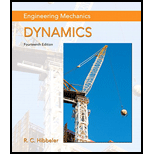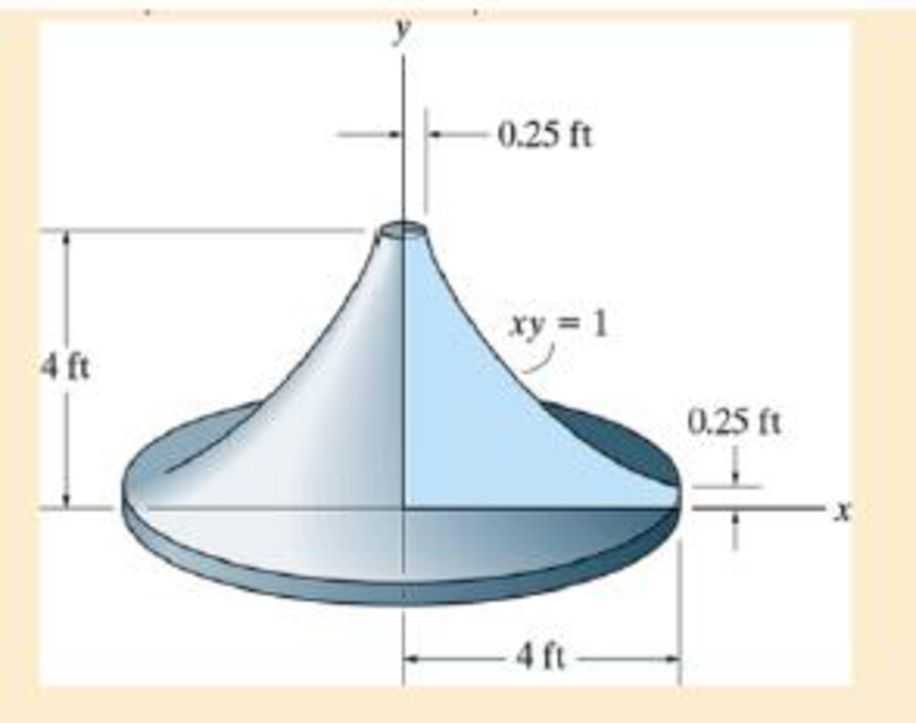
Engineering Mechanics: Dynamics Study (Book and Pearson eText)
14th Edition
ISBN: 9780134116990
Author: Russell C. Hibbeler
Publisher: PEARSON
expand_more
expand_more
format_list_bulleted
Textbook Question
Chapter 21.1, Problem 10P
The density of the material is ρ.

Expert Solution & Answer
Want to see the full answer?
Check out a sample textbook solution
Students have asked these similar questions
3 kN
3 kN
1.8 kN/m
80 mm
B
300 mm
D
an
1.5 m-1.5 m--1.5 m-
PROBLEM 5.47
Using the method of Sec. 5.2, solve Prob. 5.16
PROBLEM 5.16 For the beam and loading shown, determine the
maximum normal stress due to bending on a transverse section at C.
300 mm
3 kN
3 kN
450 N-m
D
E
200 mm
300 mm
PROBLEM 5.12
Draw the shear and bending-moment diagrams for the beam and loading
shown, and determine the maximum absolute value (a) of the shear,
(b) of the bending moment.
CORRECT AND DETAILED SOLUTION WITH FBD ONLY. I WILL UPVOTE THANK YOU. CORRECT ANSWER IS ALREADY PROVIDED. I REALLY NEED FBD.
The cantilevered spandrel beam shown whose depth tapers from d1 to d2, has a constant width of 120mm. It carries a triangularly distributed end reaction.Given: d1 = 600 mm, d2 = 120 mm, L = 1 m, w = 100 kN/m1. Calculate the maximum flexural stress at the support, in kN-m.2. Determine the distance (m), from the free end, of the section with maximum flexural stress.3. Determine the maximum flexural stress in the beam, in MPa.ANSWERS: (1) 4.630 MPa; (2) 905.8688 m; (3) 4.65 MPa
Chapter 21 Solutions
Engineering Mechanics: Dynamics Study (Book and Pearson eText)
Ch. 21.1 - Show that the sum of the moments of inertia of a...Ch. 21.1 - Determine the moment of inertia of the cone with...Ch. 21.1 - Determine moment of inertia Iy of the solid formed...Ch. 21.1 - Determine the moments of inertia Ix and Iy of the...Ch. 21.1 - The density of the material is . Express the...Ch. 21.1 - Prob. 6PCh. 21.1 - Prob. 7PCh. 21.1 - Prob. 8PCh. 21.1 - The weight of the cone is 15 lb, the height is h =...Ch. 21.1 - The density of the material is .
Ch. 21.1 - Prob. 11PCh. 21.1 - Determine the moment of inertia Ixx of the...Ch. 21.1 - Determine the product of inertia Iyz of the...Ch. 21.1 - Prob. 14PCh. 21.1 - Prob. 15PCh. 21.1 - Determine the moment of inertia of the rod about...Ch. 21.1 - Prob. 17PCh. 21.1 - Prob. 18PCh. 21.1 - Prob. 19PCh. 21.1 - Prob. 20PCh. 21.1 - Prob. 21PCh. 21.3 - If a body contains no planes of symmetry, the...Ch. 21.3 - Prob. 23PCh. 21.3 - Prob. 24PCh. 21.3 - The large gear has a mass of 5 kg and a radius of...Ch. 21.3 - Prob. 26PCh. 21.3 - Prob. 27PCh. 21.3 - Prob. 28PCh. 21.3 - Prob. 29PCh. 21.3 - Prob. 30PCh. 21.3 - Prob. 31PCh. 21.3 - Prob. 32PCh. 21.3 - The 20-kg sphere rotates about the axle with a...Ch. 21.3 - The 200-kg satellite has its center of mass at...Ch. 21.3 - Prob. 35PCh. 21.3 - Prob. 36PCh. 21.3 - Prob. 37PCh. 21.3 - Prob. 38PCh. 21.3 - Prob. 39PCh. 21.3 - Prob. 40PCh. 21.4 - Derive the scalar form of the rotational equation...Ch. 21.4 - Prob. 42PCh. 21.4 - Prob. 43PCh. 21.4 - Prob. 44PCh. 21.4 - The disk has a weight of 15 lb. Neglect the weight...Ch. 21.4 - Prob. 46PCh. 21.4 - Prob. 47PCh. 21.4 - Prob. 48PCh. 21.4 - Prob. 49PCh. 21.4 - Prob. 50PCh. 21.4 - Prob. 51PCh. 21.4 - The 5-kg circular disk is mounted off center on a...Ch. 21.4 - Prob. 53PCh. 21.4 - Prob. 54PCh. 21.4 - Prob. 55PCh. 21.4 - The 4-kg slender rod AB is pinned at A and held at...Ch. 21.4 - Prob. 57PCh. 21.4 - Prob. 58PCh. 21.4 - Prob. 59PCh. 21.4 - Show that the angular velocity of a body, in terms...Ch. 21.4 - Prob. 61PCh. 21.6 - The gyroscope consists of a uniform 450-g disk D...Ch. 21.6 - Prob. 63PCh. 21.6 - Prob. 64PCh. 21.6 - Prob. 65PCh. 21.6 - When viewed from the front of the airplane, the...Ch. 21.6 - Prob. 67PCh. 21.6 - Prob. 68PCh. 21.6 - Prob. 69PCh. 21.6 - Prob. 70PCh. 21.6 - Prob. 71PCh. 21.6 - Prob. 72PCh. 21.6 - Prob. 73PCh. 21.6 - Prob. 74PCh. 21.6 - Prob. 75PCh. 21.6 - Prob. 76PCh. 21.6 - Prob. 77PCh. 21.6 - Prob. 78P
Knowledge Booster
Learn more about
Need a deep-dive on the concept behind this application? Look no further. Learn more about this topic, mechanical-engineering and related others by exploring similar questions and additional content below.Similar questions
- CORRECT AND DETAILED SOLUTION WITH FBD ONLY. I WILL UPVOTE THANK YOU. CORRECT ANSWER IS ALREADY PROVIDED. I REALLY NEED FBD A concrete wall retains water as shown. Assume that the wall is fixed at the base. Given: H = 3 m, t = 0.5m, Concrete unit weight = 23 kN/m3Unit weight of water = 9.81 kN/m3(Hint: The pressure of water is linearly increasing from the surface to the bottom with intensity 9.81d.)1. Find the maximum compressive stress (MPa) at the base of the wall if the water reaches the top.2. If the maximum compressive stress at the base of the wall is not to exceed 0.40 MPa, what is the maximum allowable depth(m) of the water?3. If the tensile stress at the base is zero, what is the maximum allowable depth (m) of the water?ANSWERS: (1) 1.13 MPa, (2) 2.0 m, (3) 1.20 marrow_forwardCORRECT AND DETAILED SOLUTION WITH FBD ONLY. I WILL UPVOTE THANK YOU. CORRECT ANSWER IS ALREADY PROVIDED. I NEED FBD A short plate is attached to the center of the shaft as shown. The bottom of the shaft is fixed to the ground.Given: a = 75 mm, h = 125 mm, D = 38 mmP1 = 24 kN, P2 = 28 kN1. Calculate the maximum torsional stress in the shaft, in MPa.2. Calculate the maximum flexural stress in the shaft, in MPa.3. Calculate the maximum horizontal shear stress in the shaft, in MPa.ANSWERS: (1) 167.07 MPa; (2) 679.77 MPa; (3) 28.22 MPaarrow_forwardCORRECT AND DETAILED SOLUTION WITH FBD ONLY. I WILL UPVOTE THANK YOU. CORRECT ANSWER IS ALREADY PROVIDED. I REALLY NEED FBD. The roof truss shown carries roof loads, where P = 10 kN. The truss is consisting of circular arcs top andbottom chords with radii R + h and R, respectively.Given: h = 1.2 m, R = 10 m, s = 2 m.Allowable member stresses:Tension = 250 MPaCompression = 180 MPa1. If member KL has square section, determine the minimum dimension (mm).2. If member KL has circular section, determine the minimum diameter (mm).3. If member GH has circular section, determine the minimum diameter (mm).ANSWERS: (1) 31.73 mm; (2) 35.81 mm; (3) 18.49 mmarrow_forward
- PROBLEM 3.23 3.23 Under normal operating condi- tions a motor exerts a torque of magnitude TF at F. The shafts are made of a steel for which the allowable shearing stress is 82 MPa and have diameters of dCDE=24 mm and dFGH = 20 mm. Knowing that rp = 165 mm and rg114 mm, deter- mine the largest torque TF which may be exerted at F. TF F rG- rp B CH TE Earrow_forward1. (16%) (a) If a ductile material fails under pure torsion, please explain the failure mode and describe the observed plane of failure. (b) Suppose a prismatic beam is subjected to equal and opposite couples as shown in Fig. 1. Please sketch the deformation and the stress distribution of the cross section. M M Fig. 1 (c) Describe the definition of the neutral axis. (d) Describe the definition of the modular ratio.arrow_forwardusing the theorem of three moments, find all the moments, I only need concise calculations with minimal explanations. The correct answers are provided at the bottomarrow_forward
arrow_back_ios
SEE MORE QUESTIONS
arrow_forward_ios
Recommended textbooks for you
 International Edition---engineering Mechanics: St...Mechanical EngineeringISBN:9781305501607Author:Andrew Pytel And Jaan KiusalaasPublisher:CENGAGE L
International Edition---engineering Mechanics: St...Mechanical EngineeringISBN:9781305501607Author:Andrew Pytel And Jaan KiusalaasPublisher:CENGAGE L

International Edition---engineering Mechanics: St...
Mechanical Engineering
ISBN:9781305501607
Author:Andrew Pytel And Jaan Kiusalaas
Publisher:CENGAGE L
Physics 33 - Fluid Statics (1 of 10) Pressure in a Fluid; Author: Michel van Biezen;https://www.youtube.com/watch?v=mzjlAla3H1Q;License: Standard YouTube License, CC-BY